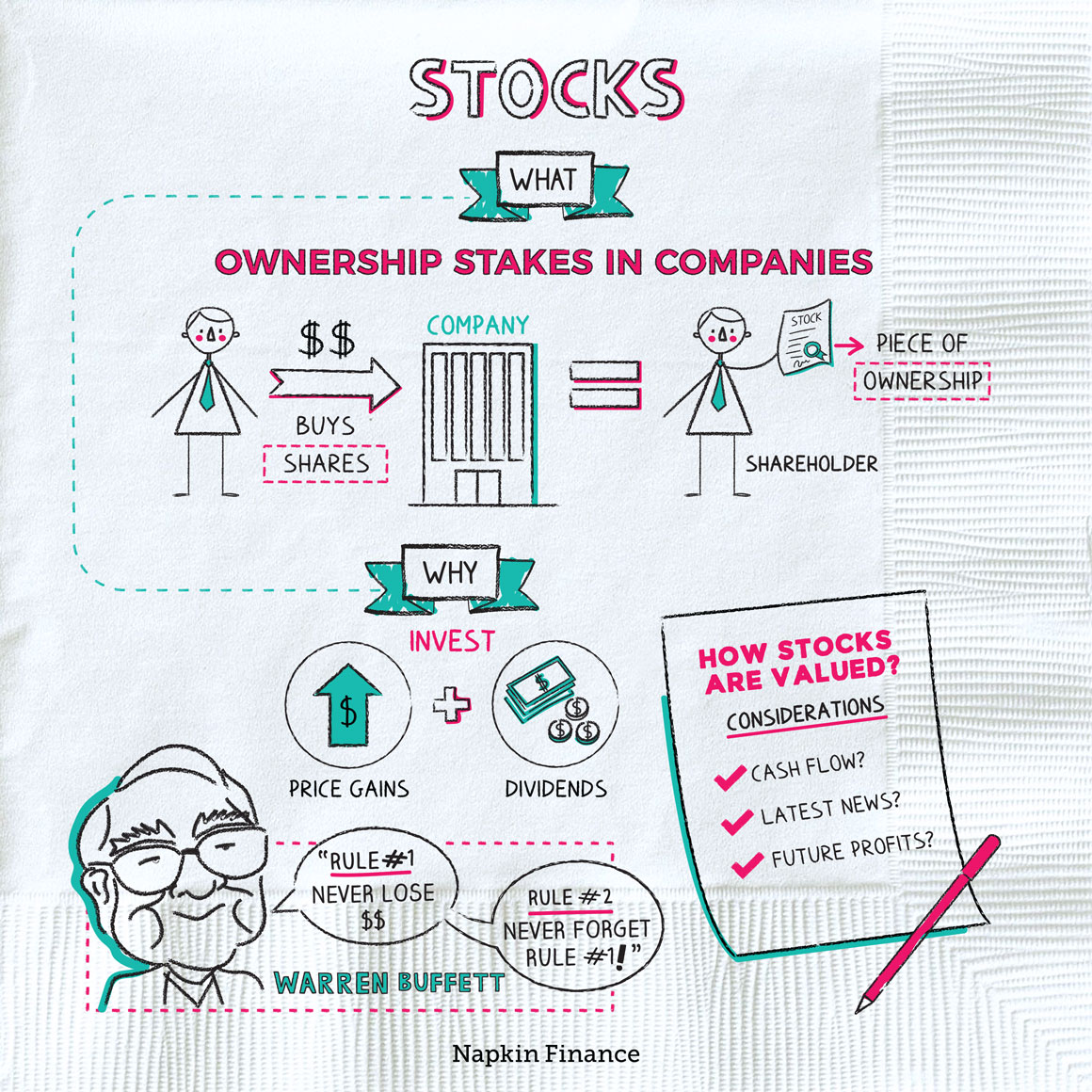Stocks
Buy Buy Buy


Stocks are pieces of ownership in companies.
If you bought one stock of, say, Amazon, and Amazon had one million shares in total, then you would own one-millionth of the company. (In reality, it has more like 500 million shares.)
People invest in stocks because they hope to earn a better return on their money than they could with a safer alternative, such as a savings account. Investors can earn returns on stocks in two main ways:
- Price gains—If you buy a stock when the share price is $100, it rises to $150, and then you sell it, then you’ve made a 50% profit.
- Dividends—Some companies pay out a portion of profits to their shareholders in the form of cash dividends. If you own a stock with a price of $100 and it pays out $2 four times a year, you’re earning about 8% per year.
There are thousands upon thousands of stocks you can choose from, and they’re generally sorted into a handful of categories, including:
- Common vs. preferred
- Common stocks—what people really mean when they talk about “stocks.”
- Preferred stocks—technically also stocks but really a different beast entirely. Preferred stocks generally pay high fixed dividend rates and don’t swing in value the way common stocks do. They’re stocks that act almost like bonds.
- Domestic vs. international
- Domestic stocks—issued by companies based in the U.S. (or an investor’s home country) though many U.S. companies do business all around the globe.
- International stocks—issued by companies headquartered elsewhere.
- Growth vs. value
- Growth stocks—issued by companies with rapidly growing sales and/or profits. (Any investor who’s hoping to find the “next Facebook” is probably focusing on growth stocks.)
- Value stocks—stocks that are selling “cheaply” compared with the underlying company’s profits.
- Large cap vs. small cap
- Large cap stocks—issued by companies with a market capitalization of $10 billion or more.
- Small cap stocks—issued by companies with a market capitalization of $2 billion or less. (There are also micro, mid, and mega capitalization stocks.)
- Sector or industry
- There are various sector and industry classifications based on what a company does, including energy, technology, healthcare, and utilities.
You might choose all your stocks from a single category, but experts usually recommend choosing some from each bucket to diversify your investments and balance your risk.
You can think of the stock market as one giant auction, except the auction never ends. Each trading day shares of Amazon (and every other publicly traded company) are potentially up for sale, and prospective buyers and sellers put out bids for what they’re willing to pay or receive for the shares.
The interplay between buyers and sellers is what drives the stock price. If one group of investors thinks Amazon stock is actually worth $4,000, then they’ll probably be willing to buy it at $3,000. If another group of investors thinks the stock is only worth $2,000, they’ll probably be willing to sell it at $3,000.
How do investors come up with their opinions of what the stock is worth? People disagree about the best way to figure out a stock’s value, but one of the most common ways is to estimate the company’s future profits, and then decide how much you’re willing to pay for those profits.
Anytime news comes out that could potentially affect the stock’s price—whether news on the company itself, the economy in general, or any issue that touches on the company’s business—then each of those investors may adjust their opinions of what the stock is worth. All those tiny adjustments are what fuel the stock’s day-to-day movements in price.
Here are some must-know terms about stocks:
- Dividend: What a company pays out periodically to shareholders. (Not all companies pay dividends. Younger companies often prefer to hold onto their cash so that they can use it to keep growing their businesses.)
- Earnings per share: The company’s total profits for a given period divided by the number of shares. It’s an estimate of what portion of profits each shareholder is “entitled to” (in theory—investors don’t actually get paid this amount).
- Share price: The price the stock is currently trading for in the market.
- Stocks, shares, and equities: These words all mean the same thing.
- Ticker symbol: A short string of letters that identifies a given stock. If you wanted to trade Amazon’s stock, you would look up its ticker, AMZN, with your broker.
Stocks are small pieces of ownership in a company that you can buy and sell in the stock market. Investors can make money on stocks through dividends, price gains, or both. There are thousands of stocks in the world, but investors make sense of them by sorting them into categories based on company size, geographic focus, industry, and more.
- Some companies get cheeky with their ticker symbols, like Harley-Davidson (HOG), mattress company Sealy (ZZ), and Heineken (HEINY).
- A “fat finger” error is when a trader accidentally adds extra digits to a trade—like the time a Lehman Brothers trader entered a stock order for £300 million instead of £3 million and briefly wiped out about £30 billion in value from the London Stock Exchange.
- Stocks are fractional shares of ownership in companies.
- People can earn a return on stocks in two main ways: through dividends and price gains.
- Dividends are portions of a company’s profits that it may pay out to shareholders periodically as cash.
- Price gains are when a company’s stock rises in price, which means investors can sell their stocks for more than they paid for them.
- You can sort stocks based on where a company is located or its industry among other factors.
- Stock prices are largely driven by investors’ expectations as to a company’s future profits.




